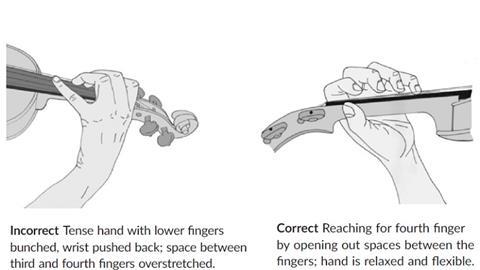Ros Stephen, author of the Oxford University Press Globetrotters series and Violinworks method books, gives exercises and advice to help string players reach fourth finger notes without straining

Frequently I come across adult learners who have difficulty playing with the fourth finger. Part of the reason for this is that many beginners start with the first finger and only gradually work their way up to using the fourth. This approach can result in the lower fingers being bunched together, with the higher fingers angled too far away from the strings – so when students start to use the fourth finger, they run into problems. Beginning with the third finger, rather than the first, can help to establish a healthier hand shape.
In the exercises that follow, I will focus on how to relax the hand so that it is flexible, positioned so that the notes fall under the fingers more easily, and able to widen from the base joints in a way that increases the reach of the fingers.
Contact points, relaxation and flexibility
There should only be two points of contact between your left hand and the instrument neck: the side of your thumb should rest against the neck just above the top joint, and the crease at the base of your first finger should rest against the E-string side of the fingerboard. The thumb should rest opposite the base of the first finger (or between the first and second fingers, if you find this more comfortable).
It’s important not to grip. Your thumb and the base of your first finger must be flexible and free if you are to play effortlessly with your fourth finger.
- Place your violin on your shoulder. Let your left arm hang freely by your side, using the weight of your head to balance the instrument.
- Breathe deeply in and out, and relax your shoulders. Now bring your left hand back up to the instrument, without gripping the neck. Your elbow should hang freely, and your forearm, wrist and hand should form a straight line when viewed from the scroll and from the side (use a mirror to check).
- Without the fingers touching the strings, gently tap your thumb against the side of the neck. Now move it around in circles, to make sure it is free.
- Keeping your thumb still and relaxed, and again without your fingers touching the strings, gently slide the base of your first finger about a centimetre to and fro along the neck (in the scroll-to-bridge direction, rather than vertically up and down). It should move freely and effortlessly.
Hand position and finger movement
It is easier to use the fourth finger if it is positioned close to the strings: the less distance it has to travel to reach the string, the better.
- Check that your left-hand fingers are relaxed and curved. Would you need to move your hand in order to place the fourth finger down on the A string? If so, rotate your forearm so that the base of your fourth finger moves closer to the neck, and move your elbow under the violin so that the tips of your fingers are hovering above the A string, or as close to it as is comfortable.
- Now gently tap the A string with your curved fourth finger (don’t worry about the pitch for now). The movement should come from the base joint. Keep your wrist, hand and other fingers relaxed.
Fourth finger unaccompanied study
Pizzicato Ping-Pong (from Chapter 8 of Violinworks Book 1)
The aim of this study is to practise keeping the fourth finger over the strings. See demonstration video below:
- Play the L.H. pizzicato notes gently, keeping the fourth finger curved and relaxed.
- Gently swing your elbow under the violin to transport the hand between the G and E strings (swing it to the right to reach the G-string and to the left to reach the E-string).
- As you move your elbow, your relaxed left-hand should pivot effortlessly about the neck of the violin so that your forearm, wrist and hand always form a straight line when viewed from the scroll, whichever string you’re on.
Play-along backing track for Pizzicato Ping-Pong by downloading the mp3 below
Downloads
4thfingerstudy
Other, Size 71.57 kbpizzicatopingpong
Other, Size 32.49 kbpizzicato-ping-pong
Other, Size 0.75 mb











































No comments yet